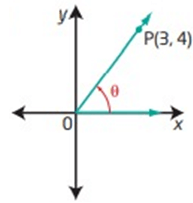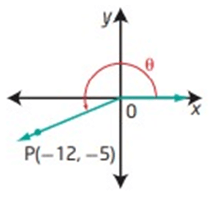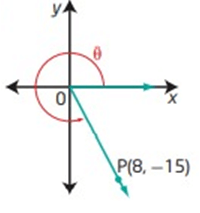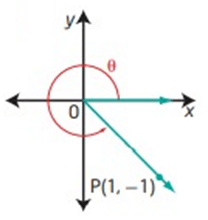EVALUATING TRIGONOMETRIC FUNCTIONS GIVEN A POINT ON THE TERMINAL SIDE
Subscribe to our ▶️ YouTube channel 🔴 for the latest videos, updates, and tips.
The coordinates of a point P on the terminal arm of each angle are shown. Write the exact trigonometric ratios sin θ, cos θ, and tan θ for each.
Problem 1 :

Solution :
By drawing a perpendicular line from P to the x-axis, we will get a right triangle. Then OP be the hypotenuse.
Use the Pythagorean Theorem,
|
OP = √(3² + 4²) OP = √(9 + 16) OP = √25 OP = 5 |
Opposite side = 4 Adjacent side = 3 Hypotenuse = 5 |
sin θ = Opposite side / Hypotenuse
sin θ = 4/5
cos θ = Adjacent side / Hypotenuse
cos θ = 3/5
tan θ = Opposite side / Adjacent side
tan θ = 4/3
Problem 2 :

Solution :
By drawing a perpendicular line from P to the x-axis, we will get a right triangle. Then OP be the hypotenuse.
|
OP = √(-12)² + (-5)² OP = √(144 + 25) OP = √169 OP = 13 |
Opposite side = -5 Adjacent side = -12 Hypotenuse = 13 |
sin θ = Opposite side / Hypotenuse
sin θ = -5/13
cos θ = Adjacent side / Hypotenuse
cos θ = -12/13
tan θ = Opposite side / Adjacent side
tan θ = -5/-12
tan θ = 5/12
Problem 3 :

Solution :
By drawing a perpendicular line from P to the x-axis, we will get a right triangle. Then OP be the hypotenuse.
|
OP = √8² + (-15)² OP = √(64 + 225) OP = √289 OP = 17 |
Opposite side = -15 Adjacent side = 8 Hypotenuse = 17 |
sin θ = Opposite side / Hypotenuse
sin θ = -15/17
cos θ = Adjacent side / Hypotenuse
cos θ = 8/17
tan θ = Opposite side / Adjacent side
tan θ = -15/8
Problem 4 :

Solution :
|
OP = √ (1)² + (-1)² OP = √ (1 + 1) OP = √2 |
Opposite side = -1 Adjacent side = 1 Hypotenuse = √2 |
sin θ = Opposite side / Hypotenuse
sin θ = -1/√2
sin θ = -√2/2
cos θ = Adjacent side / Hypotenuse
cos θ = 1/√2
cos θ = √2/2
tan θ = Opposite side / Adjacent side
tan θ = -1/1
tan θ = -1
Determine the exact of sin θ, cos θ, and tan θ if the terminal arm of an angle in standard position passes through the given point.
Problem 5 :
P (-5, 12)
Solution :
Since the given point is in the form of (-x, y), it will be in second quadrant.
Accordingly ASTC, for the trigonometric ratios sin θ and cosec θ alone we have positive.
|
Finding hypotenuse : √(-5)² + (12)² √(25 + 144) √169 13 |
Opposite side = 12 Adjacent side = -5 Hypotenuse = 13 |
sin θ = Opposite side / Hypotenuse
sin θ = 12/13
cos θ = Adjacent side / Hypotenuse side
cos θ = -5/13
tan θ = Opposite side / Adjacent side
tan θ = -12/5
Problem 6 :
P (5, -3)
Solution :
Since the given point is in the form of (x, -y), it will be in fourth quadrant.
Accordingly ASTC, for the trigonometric ratios cos θ and sec θ alone we have positive.
|
Finding hypotenuse : √5² + (-3)² √(25 + 9) √34 |
Opposite side = -3 Adjacent side = 5 Hypotenuse = √34 |
sin θ = Opposite side / Hypotenuse side
sin θ = -3/√34
cos θ = Adjacent side / Hypotenuse side
cos θ = 5/√34
tan θ = Opposite side / Adjacent side
tan θ = -3/5
Problem 7 :
P (6, 3)
Solution :
Since the given point is in the form of (x, y), it will be in fourth quadrant.
Accordingly ASTC, for all trigonometric ratios we have to use positive sign.
|
Finding hypotenuse : √6² + (3)² √(36 + 9) √45 3√5 |
Opposite side = 3 Adjacent side = 6 Hypotenuse side = 3√5 |
sin θ = Opposite side / Hypotenuse
sin θ = 3√5
= 1/√5
sin θ = 1/√5
cos θ = Adjacent side / Hypotenuse
cos θ = 6/ 3√5
cos θ = 2/√5
tan θ = Opposite side / Adjacent side
tan θ = 3/6
tan θ = 1/2
Problem 8 :
P (-24, -10)
Solution :
Since the given point is in the form of (-x, -y), it will be in third quadrant.
Accordingly ASTC, for the trigonometric ratios tan θ and cot θ alone we have positive.
|
Finding hypotenuse : √(-24)² + (-10)² √(576 + 100) √676 26 |
Opposite side = -10 Adjacent side = -24 Hypotenuse = 26 |
sin θ = Opposite side / Hypotenuse
sin θ = -10/26
sin θ = -5/13
cos θ = Adjacent side / Hypotenuse
cos θ = -24/26
cos θ = -12/13
tan θ = Opposite side / Adjacent side
tan θ = -10/-24
tan θ = 5/12
Subscribe to our ▶️ YouTube channel 🔴 for the latest videos, updates, and tips.
Recent Articles
-
Finding Range of Values Inequality Problems
May 21, 24 08:51 PM
Finding Range of Values Inequality Problems -
Solving Two Step Inequality Word Problems
May 21, 24 08:51 AM
Solving Two Step Inequality Word Problems -
Exponential Function Context and Data Modeling
May 20, 24 10:45 PM
Exponential Function Context and Data Modeling